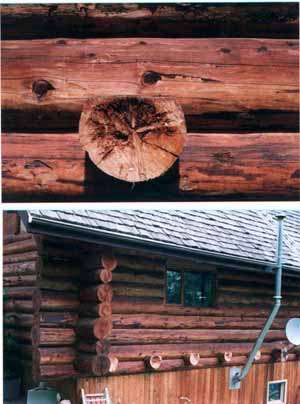Subject: dry rot log home
Date: Fri, 05 Jul 2002Dear Rot Doctor,
Attached (I hope) are four photographs of our log home which we purchased recently. It's actually a single level log duplex, but in any event was constructed in 1950 and has an approx. footprint of 40' x 45'. I'm not sure what type of wood it is. The home was a kit and the logs are 6 inches deep by 6 inches high. The house was last stained in 1980 and is well overdue for the same treatment again.
Due to the lack of maintenance, the south and west face of the home are in the worst shape with the remaining two sides overall in excellent condition. Our climate in Boise is relatively dry, and the summer's are hot. Before staining the logs again I wish to attack the existing dry rot problem. Specifically, there is one log (pictured) with open damage on the west side. It is approx. 18 inches in visible damage, and possibly more within. The other log on the south side sounds hollow when tapped, and run approx. 36 inches from end to end before sounding solid again. Fortunately I have not found any other obviously rotted or hollow sounding logs within the structure. In addition, there are several minor and major checks on the south and west sides, and only a few on the north and east sides.
After reading your web pages, my thoughts were to purchase the CPES, some epoxy filler, and the L&L resin epoxy to correct and treat the damaged logs. As much as I would like to treat the entire house with CPES before staining, I believe I better stick with the immediate problem. Question is; how much? The other question is how soon could I stain the exterior after treating the wood. Temperatures currently in Boise are approaching 100 degrees with evenings in the high 50's.
I hope I have provided you sufficient information to assist in my questions. Please e-mail me if my attached photos failed to arrive, in which case I will send them via US mail. I look forward to hearing from you.
Sincerely,
Jim B.
Jim,
Got the pictures fine. Thanks, they are always helpful. In fact, I am (hopefully) sending you a picture from one of our customers. It shows pretty well what happens inside a log. This person had a deck that extended off of one of the floors of the house. When the deck started to rot, they cut the deck logs off near the house, and so you can see a pretty typical example of how most log rot happens. If you look closely, you can see that the cracks in the log that face downward have almost no dry rot, while the upward facing cracks are much more rotted. You can also see that the rot is worse in the center, and as you get near the outside of the log, there is a "shell" of good wood. Basically, the upward facing cracks allow the water to get deep into the log, where the rot starts, while the outer "shell" of the log tends to stay drier due to wind and sun, helping to prevent the wood from reaching the 20% minimum moisture that rot fungi need to reproduce.
What this all boils down to is that the main problem is the upward facing cracks. If we could prevent the water from flowing into the logs here, any surface treatment of the log becomes merely a cosmetic issue. Many people treat the surface of the wood with stains, and while it helps the wood to look nice, it actually does little to keep it from rotting from the inside.
So my answer to the second question, "how soon can I apply stain after using CPES/L&L/Fill-It?" is, use our products on the inside of the log where the rot is happening, and use any stain you want on the surface of the log. By the way, the cups, where the logs cross, and the end grain are also problem areas. A long, thin knife blade, or stiff wire are good tools for probing down into the center of the log to feel for soft wood and voids. Generally the logs closer to the bottom are worse than the ones near the top.
This just leaves the first question, how much do you need. The answer is, it depends. A rule of thumb for CPES and log homes is 1 gallon for every 6' of bad log. When it comes to the L&L or Fill-It, it is strictly a volume issue. If you have a 2 gallon cavity, you need 2 gallons of L&L resin. You can stretch the L&L by using scrap wood, gravel, or whatever other cheap fillers you might have on hand to fill up some of the void.
Let me know if you have further questions. Or if you have trouble with the attached picture.
Doc
